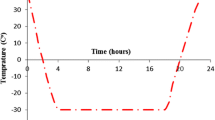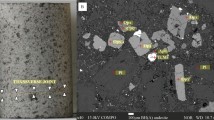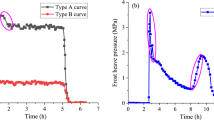Abstract
Among several weathering processes that may contribute to rock fall generation, a particular issue is related to freeze-thaw cycles. Several studies claim that many rock falls originate from thawing of the fractured bedrock during seasonal freezing (Matsuoka and Marton Permafrost Periglac Process 19(2):195–210, 2008; Matsuoka Cold Reg Scid Technol 17(3):253–270, 1990). Other authors have recently suggested that ice segregation is the real cause behind bedrock fracturing (Hallet Science 314(5802):1092–1093, 2006; Murton et al. Permafrost Periglac Process 12(3):255–266, 2001, Science 314(5802):1127–1129, 2006). Consequently, freeze and thaw processes will be deeply investigated in order to discover possible relationships between triggering mechanisms concerning rockfalls and monitoring datasets.
Laboratory tests have been carried out to investigate the rupture process caused by the abovementioned cycles. Preliminary analyses were performed both in lab and on the field with the aim of testing the capability of different transducers to register micro seismic signals.
Access provided by Autonomous University of Puebla. Download chapter PDF
Similar content being viewed by others
Keywords
Introduction
Rock falls and rock avalanches represent a diffused problem in Alpine areas featuring sudden occurrence, subtle preliminary signs and great destructive power. Progressive expansion of human settlements and climate changes that have been taking place since the last decades are probably the two main factors increasing the impact of rock falls on human settlements. The low effectiveness/cost ratio of structural measures together with great economic consequences of rock falls are driving research efforts towards the development of non-structural mitigation approaches, like rock fall forecasting systems.
One of the physical factors promoting rock falls is freeze-thaw attack, a physical mechanism causing rock mass degradation in those zones where, because of latitude and altitude, atmospheric conditions are such that 0 °C temperature is crossed several times during a year. In such situation the presence of water, which might be due to precipitations or water circulation inside the rock mass, produces cycles during which ice is consecutively formed and melt. In the traditional interpretation of the phenomenon this produces stress cycles that repeatedly load and release the rock mass, because of the 9 % volumetric expansion of water becoming ice. According to this model freeze-thaw should be able to break rock masses along pre-existent fractures. Recent investigations highlighted the existence of another freeze-thaw mechanism, namely ice segregation (Murton et al. 2001, 2006). For the example of a porous medium, this process can be schematically resumed as follows: low temperatures lead to the formation of ice lenses inside pores, covered by a film of water. This water film is able to attract water from surrounding rock through capillary cavities. This contributes to the growth of the ice lens that expands putting water in pressure; this in turn put in pressure the surrounding rock.
For these grounds, freeze-thaw can act both as a preparing cause and as a triggering factor for rock falls.
Materials and Methods
In the last decades considerable efforts have been addressed to the increasing number of rock fall events affecting human activities. Factors contributing to rock mass instabilities in the pre-Alpine foothills are: (a) the frequency and intensity of freeze-thaw cycles (60 cycles/year in average), (b) tectonization of lythotipes, (c) high dips of the slopes and (d) karsts phenomena. It has been argued (Amitrano et al. 2010) that even global climate changes could have a significant role in increasing the number of rockfalls.
Structural mitigation interventions like rock bolting, rock fall fences, rock fall nets and ditches are effective only for events involving small to medium rock volumes and low kinetic energies. For other cases non-structural measures, like monitoring systems and hazard assessment, seem to be the most effective solution for risk reduction. While hazard assessment is more suitable for land use planning stages, monitoring systems constitute an appropriate choice to reduce the risk for human settlements in built areas susceptible to rock fall events. Several kinds of instruments seem to be adequate for rock slope monitoring applications.
Conventional instruments, like extensometers and crack meters, have been extensively used in the past for rock mass monitoring, but they are able to provide only local information, giving no clue about the evolution of the global rupture process. Modern remote sensing instruments, like laser scanners and interferometric radars, feature high accuracy and scanning frequency, but yield only measures of surface movements. Because of the sudden nature of rock mass collapses, the bearing capacity of the rock mass is almost lost and failure is imminent when it is possible to detect a displacement on the surface (Arosio et al 2009). Consequently this kind of instruments is not suitable for rock mass monitoring. Conversely, previous studies pointed out that passive micro-seismic technique allows detecting stress waves released by breaking rock, providing real-time information about fracture formation, propagation and coalescence (Amitrano et al. 2010; Backers 2004; Eberhardt et al. 1998; Cai et al. 2004; Senfaute et al. 2009). Pioneer applications of acoustic and micro-seismic emission monitoring were focused on rough prediction of sudden failures in mining and tunnel construction, like rock burst and roof fall. The advent of digital technologies along with the growth of nuclear and petroleum industries fostered the development of more complex applications implying source localization and source mechanism identification. Such kind of systems have been used to optimize excavation methods to reduce the additional degree of fracturing caused by excavation in nuclear waste disposals (Cai et al 2004). Despite these progresses, applications to rock slopes are still rare at the time, because of additional complications like arduous installation conditions, huge involved volumes and presence of damaged rock mass that interferes with wave propagation resulting in signal attenuation and difficult data interpretation.
The Monitoring Network of Mount S. Martino
Mount San Martino, one of the first reliefs facing at the north side of the Po Valley, towers above the north side of the town of Lecco, 40 Km north of Milan, Italy. This mountain, characterized by vertical walls, has been historically interested by rock fall events involving material ranging from single decimetric blocks to thousands of cubic meters. Its walls are constituted by limestone belonging to the Esino Formation (middle Triassic) and represent the front of Coltignone tectonic thrust, the southernmost among the ones belonging to the Grigne group. Rock stratification is almost indistinct and is characterized by weak inclination opposing the dip-direction of the 300 m high slopes, which ranges from 70° to 90° (Agostoni et al. 2000). Fractures with N-S and E-W trends pass through the rock mass isolating dihedrals prone to toppling and wedge sliding. At the base of the cliffs debris accumulations with a maximum thickness of some tenth of meters partially hide the contact with the underlying Angolo Limestone, a calcareous formation featuring a greater degree of erodibility and thinner strata with respect to Esino limestone. This debris constitutes a slope with an inclination almost corresponding to their angle of repose, jointing the town of Lecco and Mount San Martino. This slope acts as a natural defence against rock falls on which bouncing blocks loose part of their kinetic energy.
The most catastrophic event took place in the night between 22 and 23 February 1969, when 10,000–15,000 m3 of rock detached from the rock cliff, causing the partially destruction of a building, seven fatalities and three wounded. After the 1969 calamity a series of mitigation measures have been adopted: unstable blocks have been removed from the cliff or secured with rock bolts and concrete injections. Below the cliff rock fall fences and ditches have been realized to stop bouncing blocks.
The cliff is still active: in the last 20 years a series of rock fall events involving volumes below 100 m3 have been taking place in coincidence with intense precipitations and freeze-thaw cycles.
Description of the Monitoring Network
A monitoring network has been installed in the zone of the cliff enclosing the unstable dihedral of rock adjacent to the source zone of the 1969 event where persistent fractures with centimetric aperture are present. The monitoring network is composed of eight triaxial MEMS accelerometers, three triaxial geophones and two extensometers. The average distance between sensors is about 5 m. In particular, distance between high-quality geophones is higher, while cheaper accelerometers are denser. All the microseismic monitoring instruments have been placed in cylindrical aluminium vessels solidly fixed to the rock mass ensuring a good acoustic coupling. Temperature sensors have been also placed in the boxes together with buffers that keep in memory recorded data between two following data polling performed by the acquisition system deployed at the top of the rock face.
Data saved locally are sent to the control room placed in Lecco through a radio link operating at 5.4 GHz and stored in a database.
Laboratory Tests
Freeze-thaw is a poorly understood phenomenon that is known to play an important role in creating favorable conditions for rock falls to happen and that can even act as a triggering factor. Laboratory analysis allows the simulation of particular phenomena decoupling them from others factors that are present on site. Acoustic emission monitoring can be both an instrument to investigate freeze-thaw mechanism and a tool to control the degree of evolution of rupture.
Studies published on this argument during the years have mostly focused on defining the number of freeze-thaw cycles causing rock fracture. Other studies (Matsuoka 1990, 1995; Davidson and Nye 1985; Tharp 1987) had the scope of understanding the mechanism of the phenomena, by analyzing water pressures acting on rock specimens. This second group of works is the most interesting for the target of our research.
Design and Preliminary Results of Freeze-Thaw Tests
To start analyzing the freeze-thaw process in Esino Limestone we decided to make new laboratory tests in which temperature of both air and rock, opening deformation of the slot (COD), ice pressure on rock and acoustic emissions are monitored.
One important task that has to be assured before it will be possible to monitor damage evolution in freezing conditions is to distinguish acoustic emission signals due to ice formation and slip on rock surfaces from those caused by crack propagation and coalescence. To avoid useless complications in this stage of the study we decided to work with the same material we have in the field, that is Esino limestone.
Standardized procedures for freeze-thaw testing of rocks are designed to test their suitability to be used as building materials in locations where freeze-thaw phenomenon is quite severe (UNI-087 2010). Unfortunately these tests are not suitable to investigate the mechanism of freeze-thaw attack as we wanted to do. For this reason we chose to design our first tests on the base of previous studies (Matsuoka 1990).
Esino limestone blocks (Table 1) gathered in the talus zone under S. Martino relief have been cut into cubic specimens with edges length equal to 10 cm. Slots with different sizes have been cut into these blocks as outlined in Fig. 1 and Table 2.
Sample slots have been filled with water before the samples undergone temperature cycles in a climatic cell in our laboratory. During the temperature tests we have monitored: (1) temperature on the surface and inside the samples; (2) pressure in 2–3 points along symmetry axes of the slots; (3) acoustic emissions sensed by broadband accelerometers (Figs 2 and 3).
The first test has been performed without filling the slot to check the equipment functionality and to collect acoustic emissions generated by the climatic cell itself. Data gathered at this stage have been used to filter signals collected in the following tests.
The following three tests have been conducted with: (1) one temperature cycle; (2) two temperature cycles; (3) seven temperature cycles. Cycle duration is a key parameter influencing drastically the action of ice, probably more than the lowest temperature reached. In fact, ice expansion reaches its maximum at −4 °C. On the contrary, the duration of the cycle acts on the chance of water to freeze completely as well as of the ice to melt completely. Extreme temperatures used in these cycles have been defined with reference to conditions acting averagely in zones of the province of Lecco more prone to rock falls. In these experiments we simulate the effect of freeze-thaw on open superficial fractures. According to these considerations we performed cycles in which temperatures spanned from −4 °C to 4 °C. Cycle duration was fixed to 8 h to speed up the tests. During all tests with water/ice a COD sensor installed on an unfilled sample inside the cell, has been used to measure reference values of crack opening, in order to take into account thermal deformation of the specimens.
Figure 4 illustrates an example of parameters recorded during a 7-cycle test on a dry specimen whose cut has been filled with water. Temperatures of both the cell chamber and the specimen surface have been monitored (Fig. 4 top) while pressure of the ice on the cut sides have been recorded placing sensors at the bottom and at the middle height of the fracture (Fig. 4 middle). Pressure trend during the test is well in agreement with temperature oscillations. Higher pressures are registered by the bottom transducer while both sensors display an increase of the recorded pressures as the cycles proceed.
As far as acoustic emissions are concerned (Fig. 4 bottom), we can observe the occurrence of several events in the freezing phase and of fewer events in the melting phase. Surely, part of the recorded emissions are due to the ice formation and melting processes. On the other hand, the fact that cumulative curves of collected acoustic emissions can be very different even when testing identical specimens suggests that part of the events are, with a certain degree of confidence, related to the breaking of the rock structure. Besides the influence of different slots, different behaviors of the specimens in generating acoustic emissions may be related to initial degree of fracturation and to the presence of heterogeneities that may act as preferential paths for fracture formation propagation.
Conclusions
The use of microseismic monitoring systems for rockfalls investigation and forecasting is an open problem. In order to face this issue it is necessary to analyze each triggering factor that may cause acoustic emissions.
Our work is oriented to understand one of the most significant triggering factors in the pre-alpine area, i.e., the freeze-thaw phenomenon. Our preliminary researches have addressed simple laboratory tests in which non-porous limestone specimens with a single water-filled artificial fracture have been subjected to temperature oscillations. Pressure displacements and acoustic emissions have been recorded with suitable sensors and a complete interpretation of collected parameters is still underway. Preliminary results are promising and during future investigations we aim to discriminate microseismic signals related to rock structure degradation from other events. In the future we plan to employ laboratory results to improve the interpretation of the signals collected with the monitoring network deployed on Mount San Martino.
References
Agostoni S, Cantone G, Laffi R, Ratti R, Sciunnach D (2000) Centri abitati instabili della provincia di Lecco. Pubblicazione CNR-GNDCI n. 2066
Amitrano D, Arattano M, Chiarle M, Mortora G, Occhiena C, Pirulli M, Scavia C (2010) Microseismic activity analysis for the study of the rupture mechanisms in unstable rock masses. Nat Hazards Ear Syst Sci 10:831–41
Arosio D, Longoni L, Papini M, Scaioni M, Zanzi L, Alba M (2009) Towards rockfall forecasting through observing deformations and listening to microseismic emissions. Nat Hazards Ear Syst Sci 9:1119–31
Backers T (2004) Fracture toughness determination and micromechanics of rock under mode I and mode II loading, Institut für Geowissenschaften Sektion 3.2 Deformation und Rheologie des GFZ Potsdam
Cai M, Kaiser PK, Tasaka Y, Maejima T, Morioka H, Minami M (2004) Generalized crack initiation and crack damage stress thresholds of brittle rock masses near underground excavations. Int J Rock Mech Mining Sci 41(5):833–847
Davidson GP, Nye JF (1985) A photoelastic study of ice pressure in rock cracks. Cold Reg Sci Technol 11(2):141–153
Eberhardt E, Stead D, Stimpson B, Read RS (1998) Identifying crack initiation and propagation thresholds in brittle rock. Can Geotech J 35(2):222–233
Matsuoka N (1990) Mechanisms of rock breakdown by frost action: an experimental approach. Cold Reg Scid Technol 17(3):253–270
Matsuoka N (1995) A laboratory simulation on freezing expansion of a fractured rock: preliminary data. Annu Rep Univ Tsukuba Inst Geosci 21:5–8
Murton JB, Coutard J, Lautridou J, Ozouf J, Robinson DA, Williams RBG (2001) Physical modelling of bedrock brecciation by ice segregation in permafrost. Permafrost Periglac Process 12(3):255–266
Murton JB, Peterson R, Ozouf J (2006) Bedrock fracture by ice segregation in cold regions. Science 314(5802):1127–1129
Senfaute G, Duperret A, Lawrence JA (2009) Micro-seismic precursory cracks prior to rock-fall on coastal chalk cliffs: a case study at Mesnil-Val, Normandie, NW France. Nat Hazards Ear Syst Sci9(5):1625–1641
Tharp TM (1987) Conditions for crack propagation by frost wedging. Geol Soc Am Bull 99(1):94–102
UNI-087 – UNI: PRODOTTI, PROCESSI E SISTEMI PER L’ORGANISMO EDILIZIO (2010) Natural stone test methods – determination of frost resistance
Author information
Authors and Affiliations
Corresponding author
Editor information
Editors and Affiliations
Rights and permissions
Copyright information
© 2013 Springer-Verlag Berlin Heidelberg
About this chapter
Cite this chapter
Arosio, D., Longoni, L., Mazza, F., Papini, M., Zanzi, L. (2013). Freeze-Thaw Cycle and Rockfall Monitoring. In: Margottini, C., Canuti, P., Sassa, K. (eds) Landslide Science and Practice. Springer, Berlin, Heidelberg. https://doi.org/10.1007/978-3-642-31445-2_50
Download citation
DOI: https://doi.org/10.1007/978-3-642-31445-2_50
Published:
Publisher Name: Springer, Berlin, Heidelberg
Print ISBN: 978-3-642-31444-5
Online ISBN: 978-3-642-31445-2
eBook Packages: Earth and Environmental ScienceEarth and Environmental Science (R0)








